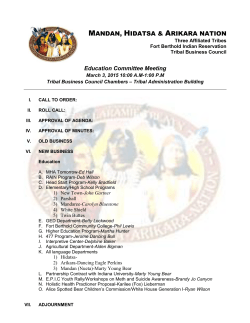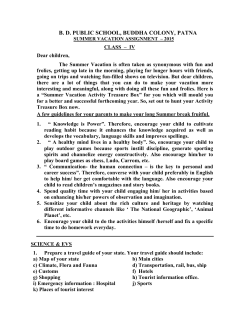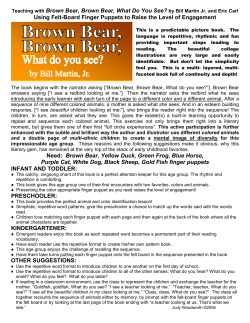
File - Dan Shaw
Understanding Sandia Mountain Black Bears Through Citizen Science Efforts Zoe van Nortwick and Anna Malvin Bosque School 4000 Learning Rd. NW, Albuquerque NM 87120 Introduction Results Conclusion Paucity of black bear (Ursus americanus) natural food supply leads to increased bear human interactions. These interactions can be dangerous for both bears and humans. Better understanding of bear diets can allow managers to predict human-bear conflict by the presence/absence of their main food sources. Through citizen science efforts, we can serve to further wildlife managers’ knowledge of black bears in the Sandia Mountains, increase the geographic scope of existing research, and educate the public about black bears, their biology, and management issues. We found bear corn (Conopholis americana), hair, acorn (Quercus), juniper (Juniperus), grass (Poaceae) insects, cactus (Opuntia), piñon (Pinus edulis), bird seed, and bone in the Elena Gallegos area bear scat samples (n=29). Bear corn was the most important item both by frequency (93.1%) and by total fecal volume (51.8%). Other undigested fecal materials found most frequently in the scat were hair (51.72%), acorn (44.83%), and juniper (41.38%). Acorn also made up a large volume of the total scat volume at 24.2%. The average weight (±SE) was 87.33g ± 9.2. The average volume (±SE) was 137.41mL ± 17.8. Gross Fecal Analysis • Bear corn was the most abundant food item found in our samples. This contradicts other scat analysis studies (1, 2) which found acorn to be the most abundant. • Taking the percent volume and the frequency of occurrence of the undigested fecal matter allows us to create a more accurate representation of the actual quantity of food items consumed. • Gross fecal analysis is inherently limited due to the differences in digestibility of different food items. • 2013 and 2014 were both average years in the ENSO cycle (i.e. not La Niña/El Niño) according to NOAA, which would suggest fewer bear human interactions according to Zack and colleagues (2003). Thus, our results may support Zack and colleagues, because we found minimal anthropogenic materials in our samples. • Evidence of anthropogenic material was found in only one scat sample containing bird seed. Percent Volume of Undigested Material Objectives Insect 0.4% • To better understand the Sandia Mountain black bear population through citizen science efforts. • To understand the diet of black bears through scat analysis. • To promote citizen scientist participation in black bear research, as well as public knowledge and awareness of black bear ecology. Outside material 12.3% Bear Corn 51.8% Unidentified 1.3% Bone 0.8% Grass 4.0% Pinon 0.7% Bird Seed 0.3% Hair 1.1% Cactus 0.3% Juniper 2.7% Citizen Science • Though the original individual DNA analysis was unsuccessful, we were able to derive useful dietary data from the scat samples. • The Sandia Mountain Bear Collaborative has been successful as a citizen science effort because it has engaged the public in research and furthered their knowledge about black bear ecology. Acorn 24.2% Figure 2: Percent volume of each food item of the undigested fecal remains from the combined 29 scats. Those materials making up <1% of the total volume were not included. Frequency of Occurence Citizen Science Background In 2013 the Sandia Mountain Bear Collaborative under the leadership of Bernalillo County (NM) Open Space was formed as a partnership between natural resource managers, researchers, and volunteer citizen scientists to create a better population estimate of black bears in the Sandia Mountains using DNA analysis of scat. That year, citizen scientists collected 100 scat samples from 9 different sites. The DNA analysis was unsuccessful because DNA amplification was not sufficient to identify individuals. In 2014 the Collaborative expanded their mission to include education and further research. This research included a citizen science effort to collect bear hair for another attempt at individual DNA analysis led by NM State University graduate student Matt Gould. We used the scat collected in 2013, as well as 7 scat samples collected in 2014 to further our knowledge of black bears through dietary analysis. M E T H O D S Collect Scat Percent Occurence Figure 1: Elena Gallegos study area Dry at 65°C for 72 hours 100 90 80 70 60 50 40 30 20 10 0 93.10 Acknowledgements Dan Shaw, Katie Elder, Rowan Converse, Stephanie Long, Rick Winslow, Matt Gould, Peter Callen, Colleen Langan, Patti Marotta, Ede Borrero, Kobie Boslough, Jerry Dragoo, Bosque School students, and the Sandia Mountain Bear Collaborative: US Forest Service, Pueblo of Sandia Environment Department, Bernalillo County Open Space, Master Naturalist Program, University of New Mexico Department of Biology, New Mexico Department of Game and Fish, Pathways: Wildlife Corridors of New Mexico, Bosque School, City of Albuquerque Open Space, Sandia Mountain Natural History Center, Bosque Ecosystem Monitoring Program (BEMP). 51.72 44.83 41.38 31.03 17.24 13.79 10.34 6.90 3.45 3.45 Works Cited Undigested Fecal Material Figure 3: Frequency of occurrence of each food item found in the undigested fecal remains in the 29 scats. Obtain dry weight (g) 1. Costello, Cecily M., Katherine A. Green Hammond, Donald E. Jones, Robert M. Inman, Kristine H. Inman, Bruce C. Thompson, Robert A. Deitner, Howard B. Quigley. 2001. “A Study of Black Bear Ecology in New Mexico with Models for Population Dynamics and Habitat Suitability.” New Mexico Department of Game and Fish; Federal Aid in Wildlife Restoration Project W-131-R. Print. 2. Graber, David M., Marshall White. 1981. “Black Bear Food Habits in Yosemite National Park.” Int. Conf. Bear Res. and Manage. 5:1-10. Print. 3. Zack, Conrad S. Bruce T. Milne, William C. Dunn. 2003. “Southern Oscillation Index as an Indicator of Encounters between Humans and Black Bears in New Mexico.” Wildlife Society Bulletin, Vol. 31, No. 2, pp. 517-520. Print. Obtain volume (ml) by water displacement Separate scat contents Analyze and record percentages of digested materials
© Copyright 2025









